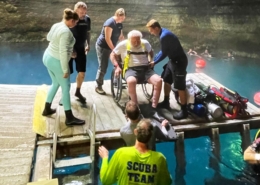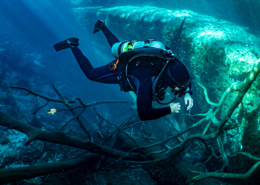Neutral Buoyancy—Let’s Get Real!
“OMG! Look at that diver, kneeling on the bottom! They should be banned from diving!”
Instant evaluation. Instant judgment.
Whether it is a photograph, video, or seeing someone in the water: instant villains. This is, in my opinion, an example of the same kind of prejudice that plagues our nation, our world. The “I am right and you are wrong” syndrome. And you know what? YOU are wrong!
Don’t misunderstand me… the ability to achieve and maintain neutral buoyancy is an important skill. Often it is critical to preserving the environment, protecting fragile animals and communities, or contributing to dive team safety. As divers, we should all be attuned to our bodies and how our actions and movements can harm the environment around us. But it takes time, often lots of time, to get there.
What really is the best way to proceed?
Coral reefs are a classic example where poor buoyancy or trim by a careless or unskilled diver can destroy decades, maybe even centuries, or growth. Many times, I have watched a diver swimming above the coral, wanting to be close enough to see and observe, but struggling not to be so close that they kick or hit anything. “Don’t touch!” they are warned during the briefing. So, in attempting to follow these directions, they inadvertently create a wide swath of intermittent devastation behind themselves, as they bob up and down, occasionally kicking the reef in sincere efforts to avoid exactly what they are causing.
Wouldn’t it be better to teach them an easier skill, one which would allow them to sidestep the potential to cause damage, and allow them more time to build better in-water skills? In this case, perhaps a better option might be to swim them over to the sandy bottom next to the reef wall. Here, they could lightly settle down to the bottom, stabilizing themselves in a location relatively immune to damage, to observe the reef and its inhabitants. They can now comfortably enjoy the dive, enjoy themselves, and not worry about damaging the environment.
How dive professionals can help
We, as dive professionals, need to take a different approach in our instruction. Instead of a “zero-tolerance” policy regarding developing buoyancy, we should be educating our students (and each other) how to assess the environment, assess their skills, and then have them select a dive location that is compatible with both. In the example above, while transiting from the shore or the boat to the reef, the diver could be gaining time in the water, learning more about themselves, and consciously working to develop a better skill set, like improving buoyancy, in an area not prone to significant damage.
But divers need to know this is OK. Pictures of divers sitting on the bottom are not being published. Divers are being told that ANY time they hit, kick, or touch the bottom, regardless of where it is, is a mortal sin. We all have done it. And, I venture to say, if we are truthful to ourselves, for the most part, we all do it still. Perhaps only occasionally, but none of us are perfect. And none of us began where we are now, skill-wise. We need to allow others the time and opportunity to do the same for themselves, without a truckload of guilt being heaped upon them.
What are some other examples?
A cave diver: It is sometimes better for a cave diver to settle slowly and calmly into the silt when control is lost, pivoting on still and stationary fin tips while reestablishing proper trim and buoyancy, rather than flailing and kicking to stay off the bottom. Cleaner, calmer, safer.
An underwater photographer: It may be better for a photographer to lightly rest a finger on a dead rock, stabilizing themselves for a picture, rather than kicking to stay off the bottom or crashing their camera into a gorgonian.
Location considerations: I grew up diving in California, often in heavy surge and poor visibility. Holding the bottom was the most realistic and effective dive technique available to stay in contact with my buddy and an awareness of where was.
The alternative
I would rather maintain control of a group of entry-level divers by firmly settling them on a durable surface (like sand), rather than risk losing control of one or more class members trying to achieve and sustain neutral buoyancy during all phases of skill instruction. Safer for them, for me, and ultimately for the organisms near us.
Newer divers are being shamed, being told they are idiots or morons. It makes diving not fun. We are losing divers because of that. Why continue with a sport where you are constantly being told you are a failure?
Let’s get real
Yes, we need to teach neutral buoyancy. Yes, it is an important skill. But it is not the only dive skill, nor is it “Rule #1” in importance. Collectively we need to discard our “Holier than thou” mentality and return to a more holistic instructional paradigm… using weighting and buoyancy (heavy, neutral, or light) as a tool, coupled with the knowledge to evaluate when and where to use them properly, and in a manner consistent with our personal skill limitations.










My take on neutral buoyancy is that it is a skill always in progress. I see this fixation on neutral buoyancy coming at the cost of more important skills – at least to me – gas management to name one. What I observe during skill improvement is a change in priorities. The example I use is that of baseball and as players advance there is a change is game playing styles. There is a new focus on teamwork and the understanding of the fine points of the game. But most divers are diving like I did when I played SAND LOT baseball. They are tickled to be underwater just like I was to pitch, catch, and bat. I could not hit the ball out of the infield and always that trouble touching the tree which was third base – but I was playing ball which was the point. No I did not have a uniform or an umpire or even a coach but that might come someday if I could catch and get on an ORGANIZED team to play on a real field. In Scuba the expectations seems to be that everyone is going to play at a high level but that is not the case. I for one have played 25 to 1 games on sandlots compare to a real ball field.
What is going on is that there is is mind set in scuba that divers progress from beginners to intermediates to advanced divers since that is the progression encouraged by the training agencies. But that is not reality as Larry Cockburn suggests at best divers are permanent intermediates. But on farther research there two other groups of participants the first of which is the parrot who only echo what they were taught the way they were taught (in my case by diving brother) and that is the mind set they follow. The second group are the casual divers who participate on trips that might be annually or at some random interval. Neither of these groups are interested the training agencies progression as they are diving to have a good time not to progress.
The industry / individuals who get focused on things like neural buoyancy at all costs have set the stage for divers who just want to dive to have fun – like me with my sandlot baseball. Sorry you will never see me on a major league team as that is and never have been my goal for participation.
Get real.
I want to improve my buoyancy and trim for diving wrecks. Do you offer courses nearby Pompano Beach FL? Thank you.
I have to agree with you, Jeffrey about the safety of kneeling vs, expecting a brand new and possibly nervous student to be expected to be neutrally buoyant while doing their first mask clear, meanwhile the other students possibly flailing around trying to stay off the bottom! NB is definitely a skill that takes practice and refinement. I have been diving for many, many years and I find myself still tweaking things as my body changes with age, or when I’m diving a less familiar environment.
It’s true how we judge other divers’ skills and/or gear (streamlining), and as dive professionals it is out duty to build our students’ confidence as well as their skills. I have been more often than not, having fewer students (usually 4) in the water at a time so I can work more closely with each one. We rotate them: for a class of 8 we will have 4 in the water while 4 on deck learning the science of diving or other pertinent things. It seems to be really effective thus far.
Thanks for your article! Happy diving!!
I agree with you, Jeffrey about the safety of kneeling vs, expecting a brand new and possibly nervous student to be expected to be neutrally buoyant while doing their first mask clear, meanwhile the other students possibly flailing around trying to stay off the bottom! NB is definitely a skill that takes practice and refinement. I have been diving for many, many years and I find myself still tweaking things as my body changes with age, or when I’m diving a less familiar environment.
It’s true how we judge other divers’ skills and/or gear (streamlining), and as dive professionals it is out duty to build our students’ confidence as well as their skills. I have been more often than not, having fewer students (usually 4) in the water at a time so I can work more closely with each one. We rotate them: for a class of 8 we will have 4 in the water while 4 on deck learning the science of diving or other pertinent things. It seems to be really effective thus far.
Thanks for your article! Happy diving!!